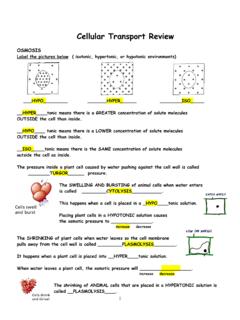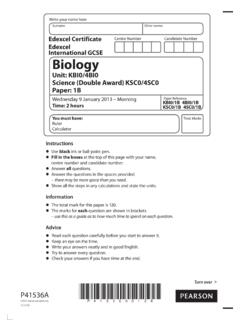Transcription of Water Potential (Ψ) - New Jersey Institute of Technology
1 Water Potential ( ) Water Potential ( ) is a measure of Water s Potential to do work. In order to do work, an object must be able to apply enough force to another object to cause displacement. In order for Water to displace another object, Water must be moving. The largest Water Potential any volume of Water can have, if only standard atmospheric pressure is being applied to that volume of Water , is defined as 0. This is the Water Potential for distilled Water . Distilled Water has the greatest Potential to move, and thus displace another object. As solute is added to distilled Water with no outside pressure being applied to it, the Water Potential of that solution drops. But what does it mean to say that the Water Potential of a solution drops? It means that the Water in that solution is less likely to do work - in other words, it is less likely to move! Why is that? Well, as solute is added, the chances become less and less that a concentration gradient can be set up between that solution and a second solution that will favor the movement of Water out of the initial solution.
2 In the example to the left, solute was added to the solution on the left side of the membrane. This decreased the chances that Water would move out of the solution to the left of the membrane and into a solution to the right of the membrane. This means that the Water on the left side of the membrane has less Potential to do work than the Water on the right side. What does this mean in terms of Water Potential ? It means that the solution to the left of the membrane has a more negative Water Potential than the solution to the right of the membrane. Therefore, Water will flow from the right side of the membrane to the left. Water always moves towards a more negative Water Potential . Let s take a look at another example. The solute Potential of a M solution of distilled Water and sucrose at 20 C at standard atmospheric pressure is If we continue adding sucrose to the solution until it reaches a concentration of M at 20 C at standard atmospheric pressure, the solute Potential continues to drop to a value of Which solution contains Water that is less likely to do work?
3 The one that has a higher concentration of solute and a lower concentration of Water ! Think about it - if we separated a solution of sucrose and a solution of sucrose with a selectively permeable membrane, which direction would the Water move? Of course it would move from the solution into the solution. In the process, it would be doing work! Remember, Water always moves from an area of higher Water Potential to an area of lower Water Potential . Now that you think you ve got Water Potential figured out, let s complicate matters a little bit! Water Potential ( ) is actually determined by taking into account two factors - osmotic (or solute) Potential ( S) and pressure Potential ( P). The formula for calculating Water Potential is = S + P. Osmotic Potential is directly proportional to the solute concentration. If the solute concentration of a solution increases, the Potential for the Water in that solution to undergo osmosis decreases.
4 Therefore, the more solute that is added to a solution, the more negative its osmotic (solute) Potential gets. If no physical pressure is applied to a solution, then the solute Potential is equal to the Water Potential . However, if physical pressure is applied to a solution, then it s Water Potential (the Potential for the Water to move and do work) will be affected. How it is affected depends upon the direction of the pressure. How could pressure be applied to a solution? Let s look at another example! If a plant cell is placed into distilled Water , obviously Water will move into the cell because distilled Water has a higher Water Potential than the plant cell itself. However, when the plant cell s central vacuole fills with Water , then it will push back out on the Water surrounding the cell. The plant cell doesn t burst due to this pressure because it has a cell wall. An animal cell in the same situation would burst.
5 When the pressure exerted outward on the Water surrounding the plant cell is equal to the osmotic Potential of the solution in the cell, the Water Potential of the cell will be equal to zero. The Water Potential of the plant cell will also be equal to the Water surrounding it, and there will be no net movement of Water molecules. Discovering Water Potential Exercise Using your class results from Exercise C of your diffusion and osmosis exercise, complete the following questions. Construct a graph by plotting % increase or decrease in mass and sucrose molarity. Determine the molar concentration of the potato core. This would be the sucrose molarity in which the mass of the potato cores does not change. To find this, draw a best fit line of your data. The point at which this line crosses the x-axis represents the molar concentration of sucrose with Water Potential that is equal to the potato tissue Water Potential .
6 At this concentration there is no net gain or loss of ater from the tissue. This concentration is part of your analysis. Calculations and Questions: 1. Calculate the solute Potential for a M sucrose solution at 22 degrees C. under standard atmospheric conditions. The solute Potential of this sucrose solution can be calculated by using the following formula: s = -iCRT i = ionization constant for sucrose (= since sucrose does NOT ionize in Water ) C = Molar concentration of the potato. R = Pressure constant liter bars/mole at degrees Kelvin T = Temperature in degrees Kelvin (273 + degrees C of solution) (Note what happens to the units.) 2. You now know the solute Potential for the solution, and you know that the pressure Potential of the solution is zero ( p = 0). Calculate the Water Potential of the solution. This calculated Water Potential is equal to the solute Potential of the solution.
7 = 0 + s or = s This Water Potential of the solution at equilibrium is equal to the Water Potential of the potato cells. What is the Water Potential of the potato cells? Show your calculations. 3. Water Potential values are useful because they allow us to predict the direction of the flow of Water . Recall from the discussion that Water flows from an area of higher Water Potential to an area of lower Water Potential . For the sake of discussion, suppose that a student calculates that the Water Potential of a solution inside the bag is bar and the Water Potential of a solution surrounding the bag is bar ( s = , p = 0). In which direction will the Water flow? Explain why. ( s = , p = 0) 4. If a potato core were allowed to dehydrate by sitting in the open air, would the Water Potential of the potato cell decrease or increase?
8 Why. 5. If a plant cell has lower Water Potential than its surrounding environment and if pressure is equal to zero, is the cell hypertonic or hypotonic in comparison to its surrounding? Will it gain or lose Water ? Explain. 6. Initial Values Beaker Contents ( sucrose solution) s = (-4) Dialysis Bag (with sucrose solution) s = (-) 1, p = 0 a. In the above figure, the beaker is open to the atmosphere. (Therefore there is no pressure on the Water in the beaker p = 0 ) Determine the pressure Potential of the system? Explain your answer. Pressure Potential is the pressure Water exerts on a cell membrane. In this case, Water will move from the baggie to the surrounding Water (the baggie is hypotonic in comparison to the surrounding Water ). As Water leaves the baggie towards an equilibrium, the pressure Potential will increase to a +1 BEAKER BAGGIE = s + p = s + p -4 = -4 + 0 -1 = -1 + 0 0 = -4 - 4 0 = -1 + 1 9.
9 Where is the Water Potential greater? Inside or outside the beaker? EXPLAIN. 10. Water will diffuse into/out of (circle one) of the bag. WHY? 11. Zucchini cores placed in sucrose solution at 27 degrees C resulted in the following percent change in mass after 24 hours. % change Sucrose molarity 20 10 -3 -17 -25 -30 a. Graph the results b. What is the molar concentration of solutes within the zucchini cells? An excellent web resource for this lab. This material is based upon work supported by the National Science Foundation under Grant Nos. EEC-0908889 Copyright 2012 by the Center for Pre-College Programs, of the New Jersey Institute of Technology . All Rights Reserved. Supporting Program: Center for Pre-College Programs, at the New Jersey Institute of Technology Contributors Courtney Ricca (Montclair High School, Montclair, NJ), Primary Author Howard Kimmel, Levelle Burr-Alexander, John Carpinelli - Center for pre-College Programs, NJIT.
10 Dr. Bilgili/Anagha Bhakay, Dr. Yueyang Shen, Dr. Boris Khusid, Rajesh Dave - C-SOPS, NJIT








